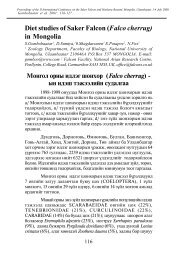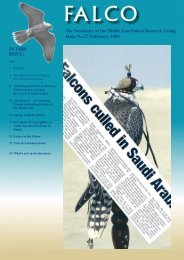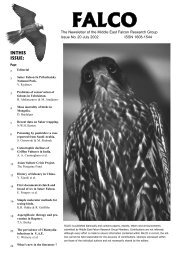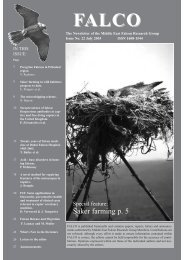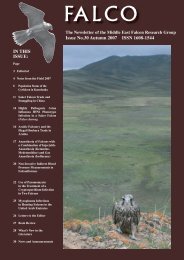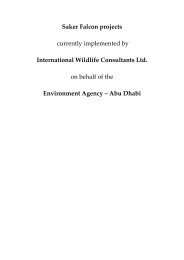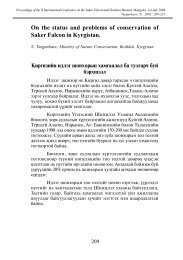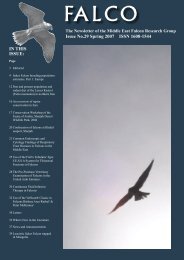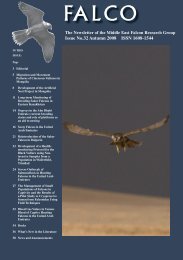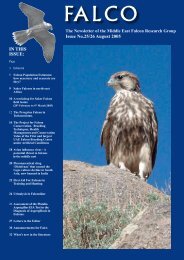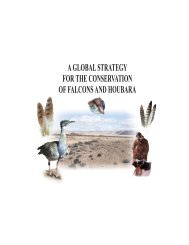Falco 28 - International Wildlife Consultants Ltd.
Falco 28 - International Wildlife Consultants Ltd.
Falco 28 - International Wildlife Consultants Ltd.
Create successful ePaper yourself
Turn your PDF publications into a flip-book with our unique Google optimized e-Paper software.
Avian Influenza<br />
U. Wernery<br />
Central Veterinary Research Laboratory, Dubai, U.A.E.<br />
Summary<br />
Avian influenza virus belongs to the Orthomyxoviridae.<br />
Only Influenza A is of veterinary importance and is<br />
divided into subtypes H1 to H16 and N1 to N9. Subtypes<br />
H5, H7 and H9 possess a high pandemic potential.<br />
Currently H5N1 poses a severe threat to humans and<br />
avian species. All birds are thought to be susceptible,<br />
and H7 and H9 have been isolated from a number of<br />
bird species in the U.A.E. The virus can cause high<br />
mortality in some avian species and no clinical signs in<br />
others. There are very good laboratory tools available<br />
for the diagnosis of avian influenza. Valuable birds<br />
should be vaccinated with a dead H5N2 vaccine.<br />
Etiology<br />
Avian influenza virus (AIV) belongs to the<br />
Orthomyxoviridae, which is divided into 3 types: A, B<br />
and C. Only Influenza A is of veterinary significance.<br />
Influenza viruses have 2 surface antigens that are<br />
important for their identification and control. They<br />
are haemagglutinin (H) and neuraminidase (N), which<br />
divide the influenza viruses into subtypes. To date,<br />
16H (H1 to H16) and 9N (N1 to N9) subtypes have<br />
been detected in wild birds and poultry throughout<br />
the world. Subtypes H5, H7 and H9 posses a high<br />
pandemic potential (Webster and Huke, 2004). The<br />
Spanish flu caused by H1N1 killed approximately 50<br />
million people worldwide in 1917/18 (WHO, 1980;<br />
Spielmann et al., 2004). Recently, H5N1 has become a<br />
major potential threat to both avian and human life. The<br />
Office <strong>International</strong> des Épizooties (OIE) differentiates<br />
between highly pathogenic influenza virus (HPAIV),<br />
which is a list A disease, and low pathogenic influenza<br />
virus (LPAIV).<br />
Host Range<br />
All birds are thought to be susceptible to AIV and the<br />
virus has been isolated from a wide variety of wild birds<br />
including migratory waterfowl and shore birds such as<br />
gulls, terns, turnstones and sandpipers (Promed, 2005).<br />
It also affects domestic turkeys and chickens. Emus and<br />
geese are also susceptible, whereas ducks and pigeons<br />
are more resistant (Munster et al., 2005 in print). Ducks<br />
especially may carry the virus around the globe. In the<br />
U.A.E., 34 AIV’s have been isolated over a 10 year<br />
period from a falcon, chickens, houbara bustards, quail,<br />
stone curlew and plovers. They belonged to the H7 and<br />
H9 subtypes (Table 1). A HPAIV H7N3 was isolated<br />
from a Peregrine <strong>Falco</strong>n (Manvell et al., 2000; Wernery<br />
and Manvell, 2003).<br />
Table 1. Influenza virus strains isolated from avian species<br />
in the United Arab Emirates (U.A.E.)<br />
Avian species Amount Strain<br />
Peregrine <strong>Falco</strong>n<br />
1<br />
1<br />
H7N3<br />
H7N1<br />
Chicken 7 H9N2<br />
Houbara Bustard<br />
3<br />
7<br />
H9N2<br />
H7N1<br />
Quail 7 H9N2<br />
Sudanese Bustard 1 H9N2<br />
W h i t e - b e l l i e d<br />
Bustard<br />
4 H9N2<br />
Stone Curlew 2 H9N2<br />
Blacksmith Plover 1 H9N2<br />
Total 34<br />
The current H5N1 outbreak originated in Asia and<br />
the present trail of infection follow the north-south<br />
migratory routes of wild birds from Kazakhstan and<br />
Russian territories towards Turkey, Romania and<br />
Croatia, but this in itself cannot be taken as proof for<br />
migratory bird populations spreading the virus (Promed,<br />
2005). Sampling of migratory birds has failed to turn up<br />
significant numbers of asymptomatic H5N1 carriers.<br />
Clinical features<br />
The virus may cause high mortality in some avian<br />
species and no clinical signs in others. The U.A.E. the<br />
HPAIV isolated from a peregrine was harmless for the<br />
falcon, but killed chickens within 3 days (Manvell et al.,<br />
2000). When clinical changes are present they include<br />
mild to severe clinical signs, anorexia, depression,<br />
decreased egg production, diarrhoea. HPAIV strains<br />
like H5N1 damages the endothelia cells resulting<br />
in bleeding disorders and fast death (Garrett, 2005).<br />
In houbara bustards, the birds developed dyspnoea,<br />
lethargy, discharge from eyes and nares, severe<br />
tracheitis, pneumonia and prancreatitis (Wernery et al.,<br />
2004).<br />
Diagnosis<br />
Virus isolation is essential not only to establish the<br />
cause of an outbreak, but also to assess the virulence<br />
of the causative virus. Specialized laboratories have to<br />
assess if the virus isolated is a HPAIV or a LPAIV. The<br />
virus is best isolated from cloacal and/or oropharyngeal<br />
swabs sent in virus transport medium or from ground<br />
tissue specimens and inoculated into allantoic cavity of<br />
10 to 12-day-old embryonated chicken eggs and onto<br />
monolayers of CEF-cell cultures. Isolated strains are<br />
subjected to haemagglutination inhibition test (HIT),<br />
ELISA’s and chicken infection experiments. Antigen<br />
19



